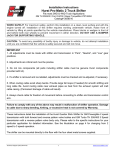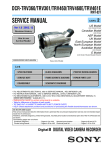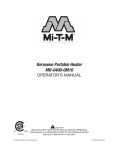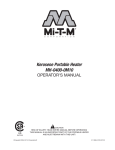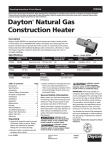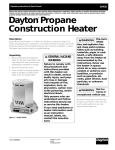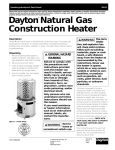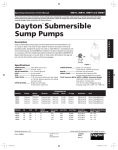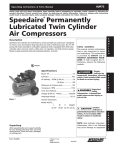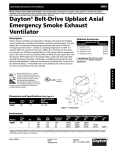Download Dayton 3VE53C Operating instructions
Transcript
3VE53C Operating Instructions & Parts Manual Please read and save these instructions. Read carefully before attempting to assemble, install, operate or maintain the product described. Protect yourself and others by observing all safety information. Failure to comply with instructions could result in personal injury and/or property damage! Retain instructions for future reference. Dayton Portable Oil-Fired Heater ® Description Dayton Model 3VE53C heater is a 400,000 BTU/Hr heater. This heater uses 1-K Kerosene for combustion, and electricity to run the fan. It is primarily intended for temporary heating of well ventilated buildings under construction, alteration, or repair. This heater may be used in agricultural, industrial and commercial environments. Specifications ELECTRICAL SPECIFICATIONS Model Electrical Input Amperage Fuse Spark Plug Gap 3VE53C 120V, 60 Hz 3 250V/8 amp .01” (2.5mm) Figure 1 – Model 3VE53C GENERAL SPECIFICATIONS Model Type of Fuel Input Rating Pump Pressure Fuel Tank Capacity Fuel Consumption Unit Size LxWxH Net Weight Lbs. (kg) 3VE53C 1-K Kerosene 400,000 BTU/Hr 130 PSI 24.0 Gallons 3.0 Gal/Hr 53” x 30” x 36” 150 (68kg) Table of Contents Page Description . . . . . . . . . . . . . . . . . . . . . . . 1 Specifications . . . . . . . . . . . . . . . . . . . . . 1 Introduction . . . . . . . . . . . . . . . . . . . . . . 1 Unpacking . . . . . . . . . . . . . . . . . . . . . . . 1 General Safety Information . . . . . . . 1-3 Product Features . . . . . . . . . . . . . . . . . . 2 Assembly . . . . . . . . . . . . . . . . . . . . . . . 4-5 Operation . . . . . . . . . . . . . . . . . . . . . . 5-8 Kerosene (1-K or Number 1 Fuel Oil). . . . . . . . . . . . . . . . 5 Overview of Heater Design . . . . . . . . . 6 Fueling Your Heater . . . . . . . . . . . . . . 6 Long-Term Storage. . . . . . . . . . . . . . 7-8 Maintenance . . . . . . . . . . . . . . . . . . . 8-10 Wiring Diagram . . . . . . . . . . . . . . . . . . 11 Repair Parts Illustration . . . . . . . . . . . . 12 Repair Parts List . . . . . . . . . . . . . . . . . . 13 Troubleshooting Chart . . . . . . . . . . 14-15 Warranty Information . . . . . . . . . . . . . 16 Introduction Please read this USER'S MANUAL carefully. It will show you how to assemble, maintain and operate this heater safely and efficiently to obtain the full benefits of its many features. Consumer: retain these instructions for future reference. Unpacking 1. Remove all packing items applied to heater for shipment. 2. Remove all items from carton. 3. Check all items for shipping damage. If heater is damaged, promptly inform dealer where you purchased heater. Indicates a potentially hazardous situation which, if not avoided, COULD result in death or serious injury. Indicates a potentially hazardous situation which, if not avoided, MAY result in minor or moderate injury. Before using this heater, please read this USER'S MANUAL very carefully. This USER'S MANUAL has been designed to instruct you as to the proper manner in which to assemble, maintain, store, and most importantly, how to operate the heater in a safe and efficient manner. Never leave the heater unattended while burning! General Safety Information Indicates an imminently hazardous situation which, if not avoided, WILL result in death or serious injury. Form 5S4857 Printed in Korea 09663 0806/234/VCPVP PIN008 08/06 ® 3VE53C Dayton Operating Instructions and Parts Manual Dayton Portable Oil-Fired Heater ® a rotten egg odor during the operation of the heater. However, #1 or #2 fuel oil (diesel fuel) may also be used if 1-K kerosene is not available. Be advised that these fuels do not burn as clean as 1-K kerosene, and care should be taken to provide more fresh air ventilation to accommodate any added contaminants that may be added to the heated space. Use of #1 or #2 fuel oil will require increased maintenance of unit. General Safety Information (Continued) Never leave the heater unattended while burning! Improper use of this heater can result in serious injury or death from burns, fire, explosion, electrical shock, and/or carbon monoxide poisoning. For optimal performance of this heater, it is strongly suggested that 1-K kerosene be used. 1-K kerosene has been refined to virtually eliminate contaminants, such as sulfur, which can cause areas! Provide at least a three square foot (2,300 sq cm) opening of outside air for every 100,000 BTU/hr of heater rating. - People with breathing problems should consult a physician before using the heater. Risk of indoor air pollution! - Use this heater only in well ventilated Dimensions 36” Dimension 53” 30” H 36” L 53” W 30” Figure 2 – Heater Dimensions Product Features Front Handle Extension Cord Wrap Hot Air Outlet Upper Shell Safety Guard Fuel Cap Fuel Gauge Lower Shell Rear Handle Side Cover Fan Guard Control Panel Fuel Tank Power Cord Drain Bolt Figure 3 – 3VE53C Features 2 Dayton Operating Instructions and Parts Manual Model 3VE53C General Safety Information (Continued) - NEVER use duct work in front or at rear of heater. - Carbon Monoxide Poisoning: Early signs of carbon monoxide poisoning resemble flu-like symptoms such as headaches, dizziness, and/or nausea. If you have these symptoms, your heater may not be working properly. - NEVER move or handle heater while still hot. - Get fresh air at once! Have the heater serviced. Some people are more affected by carbon monoxide than others. These include pregnant women, those with heart or lung problems, anemia, or those under the influence of alcohol, or at high altitudes. - Never use this heater in living or sleeping areas. Risk of Burns/Fire/ Explosion! - Use 1-K kerosene in this heater. #1 fuel oil is a suitable substitute. - NEVER use fuels such as gasoline, benzene, paint thinners, or other oil compounds in this heater (RISK OF FIRE OR EXPLOSION). - NEVER use this heater where flammable vapors may be present. - NEVER refill the heater's fuel tank while heater is operating or still hot. This heater is EXTREMELY HOT while in operation. - NEVER transport heater with fuel in its tank. This heater is equipped with a thermostat and may start at any time. - ALWAYS locate heater on a stable and level surface. - ALWAYS keep children and animals away from heater. - Bulk fuel storage should be a minimum of 25 ft. from heaters, torches, portable generators, or other sources of ignition. All fuel storage should be in accordance with federal, state, or local authorities having jurisdiction. Risk of Electric Shock! - Use only the electrical power (voltage and frequency) specified on the model plate of the heater. Use only a threeprong, grounded outlet and extension cord. CALIFORNIA RESIDENTS: This heater produces carbon monoxide, which is listed by the State of California as a reproductive toxin under Proposition 65. MASSACHUSETTS RESIDENTS: Massachusetts state law prohibits the use of this heater in any building which is used in whole or in part for human habitation. Use of this heating device in Massachusetts requires local fire dept. permit (M.E.L.C. 148, Section 10A). CANADIAN RESIDENTS: Use of this heater shall be in accordance with authorities having jurisdiction and CSA Standard B139. NEW YORK CITY RESIDENTS: For use only at construction sites in accordance with applicable NYC codes For approval numbers contact your local Grainger Branch. - ALWAYS install the heater so that it is not directly exposed to water spray, rain, dripping water, or wind. - ALWAYS unplug the heater when not in use. - Keep all combustible materials away from this heater. Minimum Clearances Outlet 8 feet (250 cm) Sides, Top and Rear 4 feet (125 cm) - NEVER block air inlet (rear) or air outlet (front) of heater. ® 3 3VE53C Dayton Operating Instructions and Parts Manual Dayton Portable Oil-Fired Heater ® Assembly Model 3VE53C Wheel Support Frame Wheels and Axle Wheel Caps Front Handle Rear Handle Cord Wraps Screws, Nuts and Washers Cotter Pins and Bushings Yes Yes Yes Yes Yes Yes Yes Yes Screws (L) Flat Washers (S) Flat Washers (L) Wheels (Pneumatic) Screws (S) Wheel Caps (Black Rubber) Nuts Cottern Pins Bushings Cord Wraps Front Handle Rear Handle Wheel Support Frame Axle Figure 4 – Component Identification 4 Dayton Operating Instructions and Parts Manual Model 3VE53C Assembly Cord Wrap TOOLS REQUIRED • MEDIUM PHILLIPS SCREWDRIVER • OPEN OR ADJUSTABLE WRENCH, USE US (INCH) SCREWS NUTS Screw (L) Safety Guard • LONG NOSE PLIERS Screw (S) ASSEMBLING WHEEL & HANDLE 1. Slide axle through wheel support frame. Install wheel bushings, flat washers (S) and wheel on axle. NOTE: When installing wheels, tube valve should face out from support frame (Figure 5). 2. Place flat washers (L) and cotter pins on axle ends and bend cotter pins with long nose pliers to secure. 3. Place wheel cap on flat washers (L) and put wheel cap in flat washers (L) end. 4. Place heater on wheel support frame. Make sure air inlet end (rear) of heater is over wheels. Align the holes on fuel tank flange. Insert screws through handles (front and rear), fuel tank flange, and wheel support frame as shown in Figure 5 and attach nut finger tight after each screw is inserted. 5. After all screws are inserted, tighten nuts firmly. DO NOT operate heater without support frame fully assembled to tank. Operation KEROSENE (1-K) For optimal performance of this heater, it is strongly suggested that 1-K kerosene be used. 1-K kerosene has been refined to virtually eliminate contaminants, such as sulfur, which can cause a Fuel Tank Flange Air Inlet Nut Wheel Support Frame Wheel (Semi-Pneumatic) Flat Washer (L) Axle Cotter Pin Flat Washer (S) Wheel Cap Bushing Wheel Tube Valve Figure 5 – Wheel and Handle Assembly rotten egg odor during the operation of the heater. However, #1 or #2 fuel oil (diesel fuel) may also be used if 1-K kerosene is not available. Be advised that these fuels do not burn as clean as 1-K kerosene, and care should be taken to provide more fresh air ventilation to accommodate any added contaminants that may be added to the heated space. NOTE: Kerosene should only be stored in a blue container that is clearly marked “kerosene”. Never store kerosene in a red container. Red containers are associated with gasoline. - NEVER store kerosene in the living space. Kerosene should be stored in a well ventilated area outside the living area. - NEVER use fuel such as gasoline, benzene, alcohol, white gas, camp stove fuel, paint thinners or other oil compounds in this heater (THESE ARE VOLATILE FUELS THAT CAN CAUSE A FIRE OR EXPLOSION). - NEVER store kerosene in direct sunlight or near a source of heat. - NEVER use kerosene that has been stored from one season to the next. Kerosene deteriorates over time. OLD KEROSENE WILL NOT BURN PROPERLY IN THIS HEATER. ® 5 3VE53C Dayton Operating Instructions and Parts Manual Dayton Portable Oil-Fired Heater ® Operation (Continued) - Use 1-K kerosene in this heater. #1 fuel is a suitable substitute. OVERVIEW OF HEATER DESIGN Fuel System: This heater is equipped with an electric magnet pump that forces fuel through the fuel line connected to the fuel intake, and then through a nozzle in the burner head. This fuel is then sprayed into the combustion chamber in a fine mist. “SureFire Ignition”: The electronic ignitor sends voltage to a specially designed spark plug. The spark plug ignites the fuel and air mixture. The Air System: The heavy duty motor turns a fan that forces air into and around the combustion chamber. Here, the air is heated and then forced out the front of the heater. THE SAFETY SYSTEM Temperature Limit Control: This heater is equipped with a Temperature Limit Control designed to turn the heater off should the internal temperature rise to an unsafe level. If this device activates and turns your heater off, it may require service. Flame-Out Sensor: Utilizes a photocell to monitor the flame in burn chamber during normal operation. It will cause the heater to shut off should the burner flame extinguish. FUELING YOUR HEATER NEVER fill the heater fuel tank in the living space: fill the tank outdoors. TO START HEATER 1. Fill fuel tank with kerosene or No. 1 fuel oil. 2. Attach fuel cap. 3. Plug power cord into three-prong, grounded extension cord. Extension cord must be at least six feet long. Do not overfill your heater and be sure heater is leveled. Extension Cord Wire Size Requirements: • 6 to 10 feet long, use 14 AWG conductor. Never refill fuel tank when heater is operating or still hot. • 101 to 200 feet long, use 12 AWG conductor. IMPORTANT: REGARDING FIRST IGNITION OF HEATER. The first time you light the heater, it should be done OUTDOORS. This allows the oils, etc. used in manufacturing the heater to burn off outside. VENTILATION Risk of indoor air pollution. Use heater only in well ventilated areas. Provide a fresh air opening of at least 3 square feet. (2,800 sq. cm.) for each 100,000 BTU/Hr. rating. Provide extra fresh air if more heaters are being used. • 201 to 300 feet long, use 10 AWG conductor. • 301 to 400 feet long, use 8 AWG conductor. • 401 to 500 feet long, use 6 AWG conductor. 4. Push “OPERATION BUTTON”. Power indicator lamp and room temperature display will light and heater will start. Push the up and down arrow keys on the control panel to adjust the thermostat settings. Fuse Barrel Once the temperature falls below the reset temperature, you will be ale to start your heater. Electrical System Protection: This heater’s electrical system is protected by a fuse that protects it and other electrical components from damage. Fuse is located inside of an in-line “FUSE BARREL”. If your heater fails to operate, check this fuse first and replace as needed. Refer to Specification Chart on page 1. Fuse Operation Button Figure 6 – Overview of Heater Design MODELS Internal Shut-Off Temp. +/-10 Degrees Reset Temp. +/-10 Degrees 3VE53C 140°F / 60°C 130°F / 54°C 6 Dayton Operating Instructions and Parts Manual Model 3VE53C Operation (Continued) If heater does not start, the thermostat setting may be too low. Push “TEMP CONTROL UP ARROW” to higher setting to start heater. If heater still does not start, see Troubleshooting Chart on page 14-15. NOTE: The major electrical components of this heater are protected by a circuit breaker (fuse) mounted to the power switch. If your heater fails to start, check this first and replace as necessary. You should also check your power source to insure that proper voltage and frequency are being supplied to the heater. 1. Push “OPERATION BUTTON”, This will cause heater flame to go out. The motor will continue to run during the cooling cycle. This allows the fan to cool the combustion chamber. When the cooling cycle (approx. 2 minutes) is finished, the motor will stop. Do not unplug heater until cooling cycle is finished. 2. Disconnect heater from power source. 3. To temporarily stop heater, set thermostat at a temperature lower than air around heater. Heater will cycle back on if air temperature around heater matches thermostat setting. Figure 8 – Electrical Outlet LONG-TERM STORAGE OF HEATER TO RESTART HEATER DO NOT restart heater until cooling cycle is finished. Operation Button Temp Control Buttons Figure 7 – Control Parts The cooling cycle cools the combustion chamber. Figure 9 – Drain Bolt Removal 1. Wait until cooling cycle is finished after stopping heater. 1. Remove drain nut from rear bottom side of fuel tank by unscrewing nut and drain. See Figure 9. 2. Repeat steps under TO START HEATER. ELECTRICAL OUTLET Shock Hazard! TO STOP HEATER Never unplug heater while heater is running. Heater must go through cooling cycle. The cooling cycle cools the combustion chamber. Damage to heater can occur if combustion chamber is not cooled. Do not restart heater until cooling cycle is complete. Drain Bolt - Never plug in an appliance with more than 5amp rating in this outlet. - Always keep outlet covered when not in use. 2. Using a small amount of kerosene, swirl and rinse the inside of the tank. NEVER MIX WATER WITH KEROSENE, as it will cause rust inside the tank. Pour the kerosene out, making sure that you remove it all. IMPORTANT: Do not store kerosene over summer for use during next heating season. Using old fuel may damage heater. - 120V 5amp max (non fused). ® 7 3VE53C Dayton Operating Instructions and Parts Manual Dayton Portable Oil-Fired Heater ® Operation (Continued) Never service heater while it is plugged in 3. Reinstall drain bolt as follows: - Insert bolt’s seal head fully into drain hole so that flange is flush to tank’s bottom. See Figure 10. - Insert seal cap fully into head hole so that cap flange is flush to head flange. (See Figure 10). - Remove lead wire from spark plug. Maintenance or while hot! NOTE: USE ORIGINAL EQUIPMENT REPLACEMENT PARTS. Use of thirdparty or other alternate components will void warranty and may cause unsafe operating conditions. FUEL TANK - Flush every 200 hours of operation or as needed (See Storage, page 7). Drain Bolt - Remove spark plug from burner head. - Carefully remove nozzle from burner head using socket wrench. - Blow compressed air through face of nozzle (This will remove any dirt). - Inspect nozzle for damage. If damaged or clogged, replace nozzle. - Make sure plug is in place on burner head. - Reinstall nozzle into burner head and tighten firmly (175-200 inch-pounds). FAN BLADES - Reinstall spark plug in burner head. CLEAN EVERY SEASON OR AS NEEDED. - Attach burner head to combustion chamber. - Remove upper shell (See air intake filter). - Attach spark plug wire to spark plug - Use Allen wrench to loosen set screw which holds fan blade to motor shaft. - Attach fuel line to burner head and tighten firmly. - Slip fan blade off motor shaft. - Replace upper shell. - Clean fan blade using soft cloth moistened with kerosene or solvent. Drain Nut Drain Bolt - Dry fan blade thoroughly. - Reinstall fan blade to motor shaft. (Bottom-Front of Fuel Tank) - Place fan hub flush with end of motor shaft. Figure 10 – Drain Bolt Reinstall - Place set screw on flat end of shaft. IMPORTANT: Reinstall bolt fully into hole in tank; otherwise it will not seal completely. - Make sure storage place is free of dust and corrosive fumes. - Store the heater in the original box with the original packing material and keep USER'S MANUAL with heater. Nozzle - Tighten screw firmly (40-50 inch pounds/ 4.5-5.6 N-m). Reinstall upper shell NOZZLE Remove dirt in nozzle as needed (see page 12). photocell - Remove upper shell. - Remove fuel line B from burner assembly by using wrench. - Remove burner head from burner assembly. 8 Figure 11 – Nozzle Replacement Dayton Operating Instructions and Parts Manual Model 3VE53C Maintenance (continued) Spark Plug PHOTOCELL Photocell CLEAN PHOTOCELL ANNUALLY OR AS NEEDED. - Remove upper shell. - Remove fan (See fan blades). - Remove photocell from its mounting bracket - Clean photocell lens with cotton swab. Nozzle Figure 12 – Nozzle TO REPLACE: Remove side cover near Operation switch. - Attach ignitor wire to spark plug. - Disconnect wires from Operation switch and remove photocell. - Attach fuel and air line hoses to burner head. - Reinstall fan blade and upper shell. SPARK PLUG CLEAN AND REGAP EVERY 600 HOURS OF OPERATION OR REPLACE AS NEEDED. - Remove upper shell. - Disconnect wires from circuit board and remove side cover. Figure 15 – Photocell Replacement - Install new photocell and attach wires to circuit board. - Replace switch wires to operation switch and side cover. - Replace fan and upper shell. - Remove spark plug wire from spark plug (See Figure 13). - Remove spark plug from burner head using medium Phillips screwdriver. - Clean and regap spark plug electrodes to 0.1” (2.5 mm) gap. - Reinstall spark plug into burner head. - Attach spark plug wire to spark plug. - Reinstall upper shell. Spark Plug Figure 14 – Photocell Lead Wire Nozzle Figure 13 – Spark Plug Replacement ® 9 3VE53C Dayton Operating Instructions and Parts Manual Dayton Portable Oil-Fired Heater ® - Stop heater (See OPERATION, page 7). Maintenance (Continued) FUEL FILTER CLEAN TWICE PER HEATING SEASON OR AS NEEDED. Pressure adjusting Screw used, remove pressure gauge. - Replace pressure gauge, and plug in end of filter cover. Fuel filter A on fuel cap NOTE: If heater does not ignite when heater is turned on, please turn AIR VENT SCREW counter clockwise to release air, then turn OPERATION SWITCH back on. - Remove fuel cap. - Take out fuel filter with clean kerosene. - Wash fuel filter with clean kerosene. - Replace fuel filter on fuel tank. - Replace fuel cap on fuel tank. Air vent Screw Fuel filter B on fuel line (See Figure 16) Figure 17 – Pump Pressure Adjustment - Remove fuel line A from fuel pump by using wrench. - Take out fuel line from fuel tank by pulling out fuel filter gasket. - Remove fuel filter assembly from fuel line - Wash fuel filter in clean kerosene. - Reassemble fuel filter in reverse order. Fuel Cap Fuel Line A Fuel Line A Gasket Fuel Cap Gasket Fuel Filter A Fuel Filter B Figure 16 – Remove Tank Fuel Filter PUMP PRESSURE ADJUSTMENT - Remove right side panel. - Remove fuel line A from fuel pump by using wrench. If accessory pressure gauge is being - Replace pressure gauge at outlet of fuel pump. - Adjust pump pressure by turning pressure adjustment screw - Replace pressure gauge at outlet of fuel pump. - Adjust pump pressure by turning pressure adjustment screw. - Turn relief valve clockwise to increase pressure. - Turn relief valve counterclockwise to decrease pressure. - Set pump pressure to 130 PSI. We recommend pump pressure adjusting is not needed if red marking on pump body and adjusting screw is aligned with each other. NOTE: Use only original equipment replacement parts. Use of alternate or third party components will void any warranty and may cause unsafe operating conditions. 10 Dayton Operating Instructions and Parts Manual Model 3VE53C Wiring Diagrams ® 11 3VE53C Dayton Operating Instructions and Parts Manual For Repair Parts, call 1-800-323-0620 24 hours a day – 365 days a year Please provide following information: -Model number -Serial number (if any) -Part description and number as shown in parts list Address parts correspondence to: Grainger Parts P.O. Box 3074 1657 Shermer Road Northbrook, IL 60065-3074 U.S.A. 44 27 Figure 18 – Repair Parts Illustration for Portable Oil-Fired Heater 12 Dayton Operating Instructions and Parts Manual Model 3VE53C Repair Parts List for Portable Oil-Fired Heater Ref. No. Description Part No. 1 2 3 4 5 6 7 8 9 10 11 12 13 14 15 16 17 18 19 20 21 22 23 24 25 Upper Shell Chamber Assembly Lower Shell Baffle Bracket Rear Fuel Tank Assembly Right Side Cover PCB Case Lower PCB Case Upper P.C.B. Assembly Air Baffle Plate Bushing Grommet (S) Fuel Cap Assembly Fuel Filling Filter Fuel Line Assembly (A) Fuel Gauge Assembly Magnetic Pump Assembly Ignitor Cord Bushing Power Cord Assembly Wheel Support Frame Wheel Axle Pneumatic Wheel Split Pin Wheel Bushing Flat Washer (A) 70-001-1401 70-011-0600 70-001-1402 70-001-0608 70-002-0400 70-008-0500 70-027-0702 70-027-0703 70-027-0800 70-012-0100 70-017-0200 70-006-0200 70-006-0300 70-036-0700 70-007-0200 70-020-0700 70-037-0700 70-033-0200 70-034-0300 70-064-0100 70-041-0303 70-041-0110 70-041-0107 70-041-0109 70-041-0105 Qty. 1 1 1 4 1 1 1 1 1 1 5 1 1 1 1 1 1 1 1 1 1 2 2 2 2 Ref. No. Description Part No. 26 27 28 29 30 31 32 33 34 35 36 37 38 39 40 41 42 43 44 45 46 47 48 49 Wheel Cap Fan Guard Left Side Cover Socket Cover Electrical Outlet Assembly Bushing Grommet (L) Thermostat Thermostat Bracket Rubber Bushing Burner Blower Fan Assembly Photocell Assembly Air Control Head Assembly Spark Plug Nozzle Burner Motor Assembly Fan Fixing Screw M8x8 Fan Assembly Air Motor Assembly Motor Supporter Safety Guard Front Handle Rear Handle Cord Wrap Drain Bolt 70-041-1111 70-016-0300 70-009-0500 70-030-0100 70-029-0100 70-018-0200 70-019-0500 70-019-0501 70-018-0300 70-063-0300 70-016-0150 70-014-0701 70-052-0400 70-015-0750 70-063-0200 70-024-0700 70-021-0700 70-020-0407 70-065-0100 70-042-0300 70-043-0300 70-032-0200 70-002-0107 Qty. 2 1 1 1 1 1 1 1 1 1 1 1 1 1 1 1 1 1 1 1 1 1 2 1 ® 13 3VE53C Dayton Operating Instructions and Parts Manual Dayton Portable Oil-Fired Heater ® Troubleshooting Chart Symptom Possible Cause(s) Heater ignites but Main PCB assembly shuts heater off after a short period of time (Lamp is flickering) E1 Heater will not ignite, but motor runs for a short period of time (Lamp is flickering) E1 Fan does not turn when heater is plugged in. Corrective Action 1. Wrong pump pressure 1. See Pump Pressure Adjustment, Page 10 2. Dirty fuel filter 2. See Fuel Filter, Page 10 3. Dirt in nozzle 3. See Nozzle, Page 8 4. Dirty photocell lens 4. Clean Photocell Lens, Page 9 5. Photocell assembly not properly installed (not seeing flame) 5. Make sure photocell boot is properly seated in bracket (See page 9) 6. Bad electrical connection between photocell and Main PCB assembly 6. Check electrical components (See Wiring Diagrams, Page 11) 7. Defective photocell 7. Replace Photocell, Page 9 1. No fuel in tank 1. Fill tank with kerosene 2. Wrong pump pressure 2. See Pump Pressure Adjustment, Page 10 3. Carbon deposits on spark plug and/or improper gap 3. See Spark Plug, Page 9 4. Dirty fuel filter 4. See Fuel Filter, Page 10 5. Dirt in nozzle 5. See Nozzle, Page 8 6. Water in fuel tank 6. Flush fuel tank with clean kerosene, page 7 7. Bad electrical connection between ignitor and Main PCB assembly 7. Check electrical connections (See Wiring Diagrams, Page 11) 8. Ignitor Wire not attached to spark plug 8. Attach ignitor wire to spark plug (See Spark Plug, Page 9) 9. Defective ignitor 9. Replace ignitor 1. Thermostat setting too low 1. Adjust thermostat to a higher setting 2. Poor electrical connection between motor and Main PCB assembly 2. Check electrical connections (See Wiring Diagrams, Page 11) 1. Switch Failure 1. Replace Switch 2. Short Circuit 2. Check Wiring and connection E1 or E2 E3 14 Dayton Operating Instructions and Parts Manual Model 3VE53C Troubleshooting Chart (Continued) Symptom Possible Cause(s) Corrective Action Sensor disconnected A. Check limit control thermostat E4 B. Check sensor connection E5 Temperature limit safety device is overheated 1. Poor Combustion Wait until unit cools down 1. Poor Combustion - Flames extending beyond heater - Low heat output - Align the red mark between the air screw and pump body Other Problems 2. Power Failure 2. Power Failure - No power supply to heater - Check / Replace Fuse ® 15 Dayton Operating Instructions and Parts Manual 3VE53C Dayton Portable Oil-Fired Heater ® LIMITED WARRANTY DAYTON ONE-YEAR LIMITED WARRANTY. Dayton® Portable Oil-Fired Heater, Model covered in this manual, is warranted by Dayton Electric Mfg. Co. (Dayton) to the original user against defects in workmanship or materials under normal use for one year after date of purchase. Any part which is determined to be defective in material or workmanship and returned to an authorized service location, as Dayton designates, shipping costs prepaid, will be, as the exclusive remedy, repaired or replaced at Dayton’s option. For limited warranty claim procedures, see PROMPT DISPOSITION below. This limited warranty gives purchasers specific legal rights which vary from jurisdiction to jurisdiction. LIMITATION OF LIABILITY. To the extent allowable under applicable law, Dayton’s liability for consequential and incidental damages is expressly disclaimed. Dayton’s liability in all events is limited to and shall not exceed the purchase price paid. WARRANTY DISCLAIMER. Dayton has made a diligent effort to provide product information and illustrate the products in this literature accurately; however, such information and illustrations are for the sole purpose of identification, and do not express or imply a warranty that the products are MERCHANTABLE, or FIT FOR A PARTICULAR PURPOSE, or that the products will necessarily conform to the illustrations or descriptions. Except as provided below, no warranty or affirmation of fact, expressed or implied, other than as stated in the “LIMITED WARRANTY” above is made or authorized by Dayton. PRODUCT SUITABILITY. Many jurisdictions have codes and regulations governing sales, construction, installation, and/or use of products for certain purposes, which may vary from those in neighboring areas. While Dayton attempts to assure that its products comply with such codes, it cannot guarantee compliance, and cannot be responsible for how the product is installed or used. Before purchase and use of a product, review the product applications, and all applicable national and local codes and regulations, and be sure that the product, installation, and use will comply with them. Certain aspects of disclaimers are not applicable to consumer products; e.g., (a) some jurisdictions do not allow the exclusion or limitation of incidental or consequential damages, so the above limitation or exclusion may not apply to you; (b) also, some jurisdictions do not allow a limitation on how long an implied warranty lasts, consequentially the above limitation may not apply to you; and (c) by law, during the period of this Limited Warranty, any implied warranties of implied merchantability or fitness for a particular purpose applicable to consumer products purchased by consumers, may not be excluded or otherwise disclaimed. PROMPT DISPOSITION. Dayton will make a good faith effort for prompt correction or other adjustment with respect to any product which proves to be defective within limited warranty. For any product believed to be defective within limited warranty, first write or call dealer from whom the product was purchased. Dealer will give additional directions. If unable to resolve satisfactorily, write to Dayton at address below, giving dealer’s name, address, date, and number of dealer’s invoice, and describing the nature of the defect. Title and risk of loss pass to buyer on delivery to common carrier. If product was damaged in transit to you, file claim with carrier. Manufactured for Dayton Electric Mfg. Co., 5959 W. Howard St., Niles, Illinois 60714 U.S.A. Manufactured for Dayton Electric Mfg. Co. Niles, Illinois 60714 U.S.A. ®
















